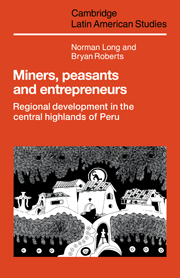Book contents
- Frontmatter
- Contents
- List of tables
- List of figures
- List of maps
- Preface
- 1 Regional development in an export economy
- 2 The development of a regional economy in the central highlands
- 3 The Mining Corporation and regional development
- 4 Class relations, local economies and large-scale mining
- 5 Highland puna communities and the impact of the mining economy
- 6 Migration and social differentiation amongst Mantaro valley peasants
- 7 Industrialization and the emergence of an informal regional economy
- 8 The village economy, agricultural development and contemporary patterns of social differentiation
- 9 Regional commitment among central highlands migrants in Lima
- 10 Confederations of households: extended domestic enterprises in city and country
- 11 Regional development in peripheral economies
- Notes
- Bibliography
- Index
- Titles in the series
7 - Industrialization and the emergence of an informal regional economy
Published online by Cambridge University Press: 07 May 2010
- Frontmatter
- Contents
- List of tables
- List of figures
- List of maps
- Preface
- 1 Regional development in an export economy
- 2 The development of a regional economy in the central highlands
- 3 The Mining Corporation and regional development
- 4 Class relations, local economies and large-scale mining
- 5 Highland puna communities and the impact of the mining economy
- 6 Migration and social differentiation amongst Mantaro valley peasants
- 7 Industrialization and the emergence of an informal regional economy
- 8 The village economy, agricultural development and contemporary patterns of social differentiation
- 9 Regional commitment among central highlands migrants in Lima
- 10 Confederations of households: extended domestic enterprises in city and country
- 11 Regional development in peripheral economies
- Notes
- Bibliography
- Index
- Titles in the series
Summary
Post Second World War industrialization in Peru marked a new phase in regional development. It resulted in the undermining of the regional system of production based on large-scale, agro-mining enterprise and led to an increasing centralization of population and resources in the metropolitan area of Lima-Callao. In this chapter, we explore the significance of these changes for contemporary patterns of socio-economic activity in the central highlands. We claim that, despite the disarticulation of the region, the previous mine-based system of production continues to influence the ways in which local groups attempt to handle and interpret the significance of these new forces of change. In the following chapters, we identify some of the more important sociocultural mechanisms and relationships which are characteristic of this process. The present chapter focusses upon Huancayo in the contemporary period, as its role shifts from that of an administrative and commercial centre of the agro-mining economy to that of a centre for government services surrounded by a burgeoning small-scale economic sector.
The period following the Second World War is one in which the Peruvian population increasingly concentrated in the metropolitan area of Lima-Callao. In 1940, the metropolitan area contained 10 per cent of the national population while, in 1972, its share had increased to nearly 25 per cent. This population concentration was due, in large part, to the increasing importance of manufacturing industry and the concentration of that industry in Lima-Callao. By the 1970s, the metropolitan area concentrated a growing and major part of Peru's industrial production (Wils, 1979: 41; Gonzales, 1982: 262). Growth in the industrial product averaged between 7 and 8 per cent a year from 1950 to 1975.
- Type
- Chapter
- Information
- Miners, Peasants and EntrepreneursRegional Development in the Central Highlands of Peru, pp. 140 - 168Publisher: Cambridge University PressPrint publication year: 1984



